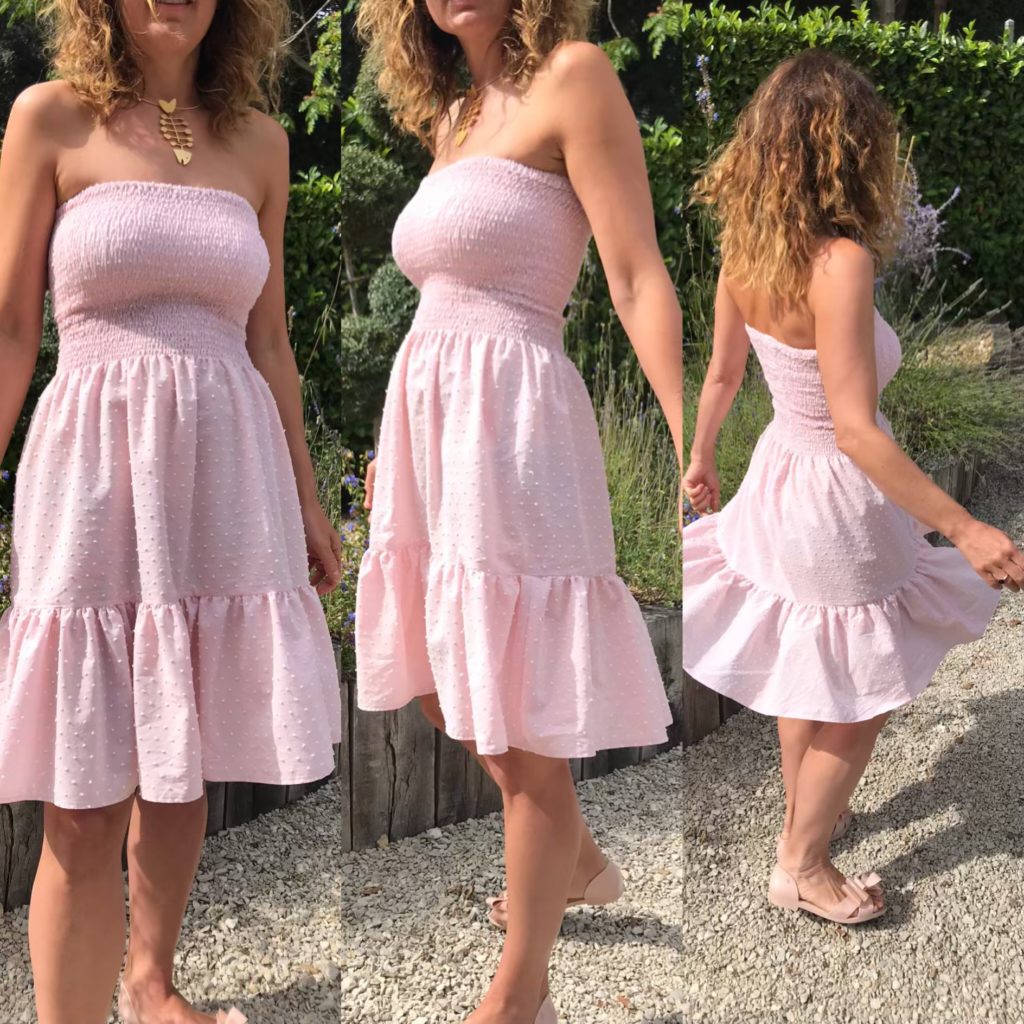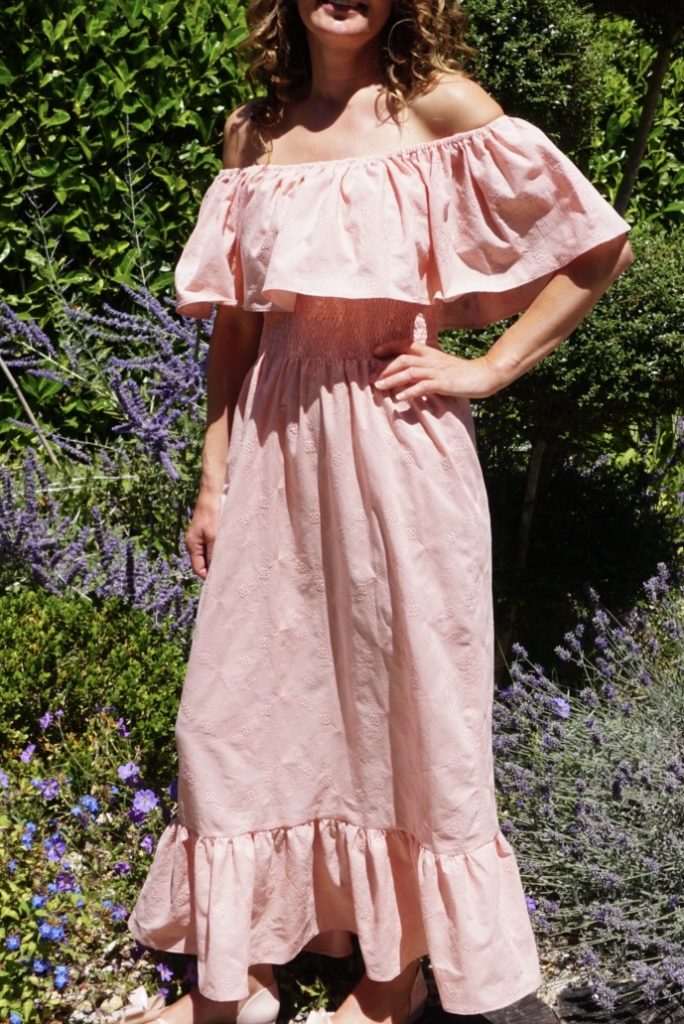My broderie anglaise M7952 dress
I have been wanting to sew a broderie anglaise summer dress for many many moons – here it is finally, with my latest handmade version of the M7952 pattern!

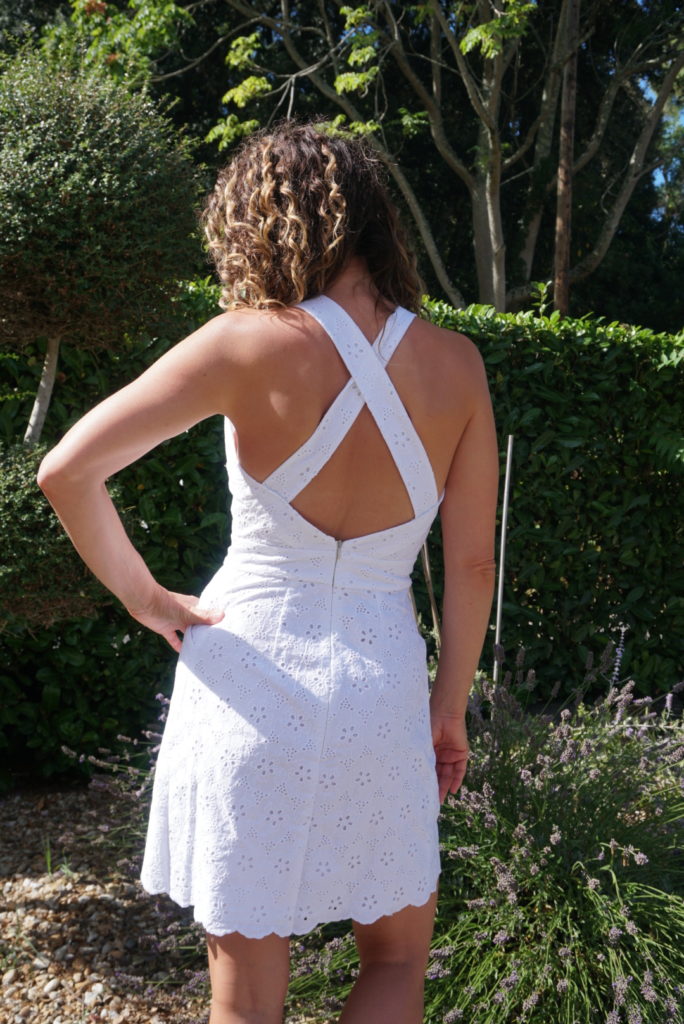

Inspiration for this dress
My love-affair with broderie anglaise has been going on for years but the inspiration for this specific dress emerged last year, with the release of the Alesia dress pattern by Cozy Little World. One of the presentation dresses was in white broderie anglaise and it was love at first sight!
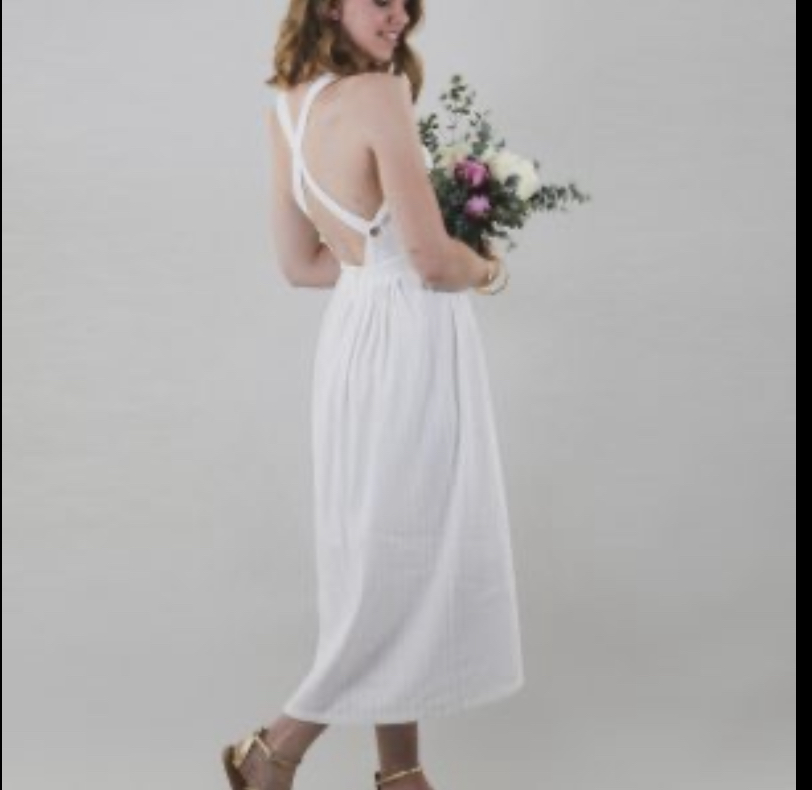
And my love for apron-style dresses was reinforced further by a series of beautiful dresses offered by French clothing brand Sezane over last summer.
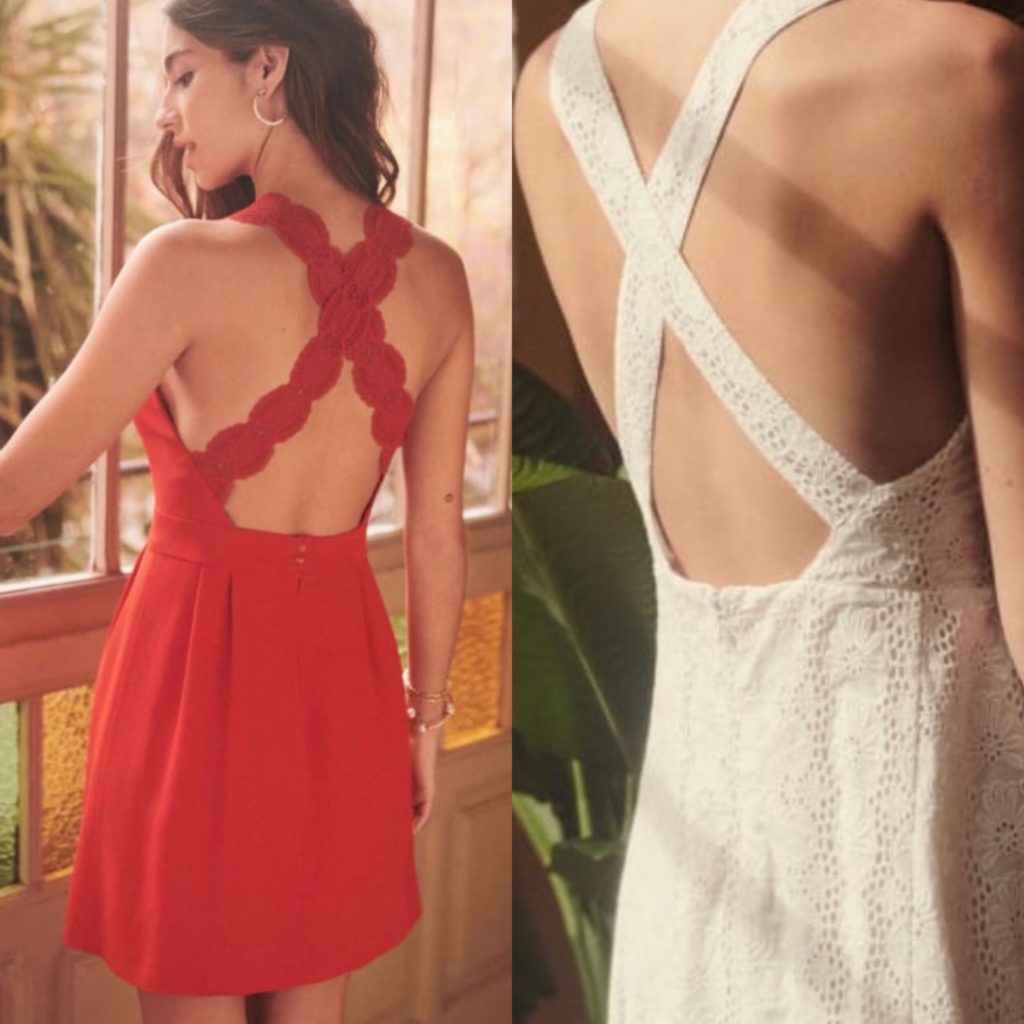
Despite the enthusiasm it created in the French sewing community, I was held off using the Alesia pattern by the fact I never made a Cozy Little World dress before (I did make the Monceau cardi and it was great though), so I was dreading the prospect of getting it to my standard of perfect fit… I am a bit complicated I know… And then came the issue of the M7952 pattern, hurrah!
M7952 pattern review and modifications
I am a huge fan of McCall’s and Vogue dress patterns because I know that if I make a size 10, it will fit like a glove without any fitting required – except for an FBA when the pattern in not offered with cup options. This specific pattern was no exception, the fit is just so good!
You may (or may not) remember that I already made a striped version of M7952 a few months ago, so the full review of the pattern can be found in this article.
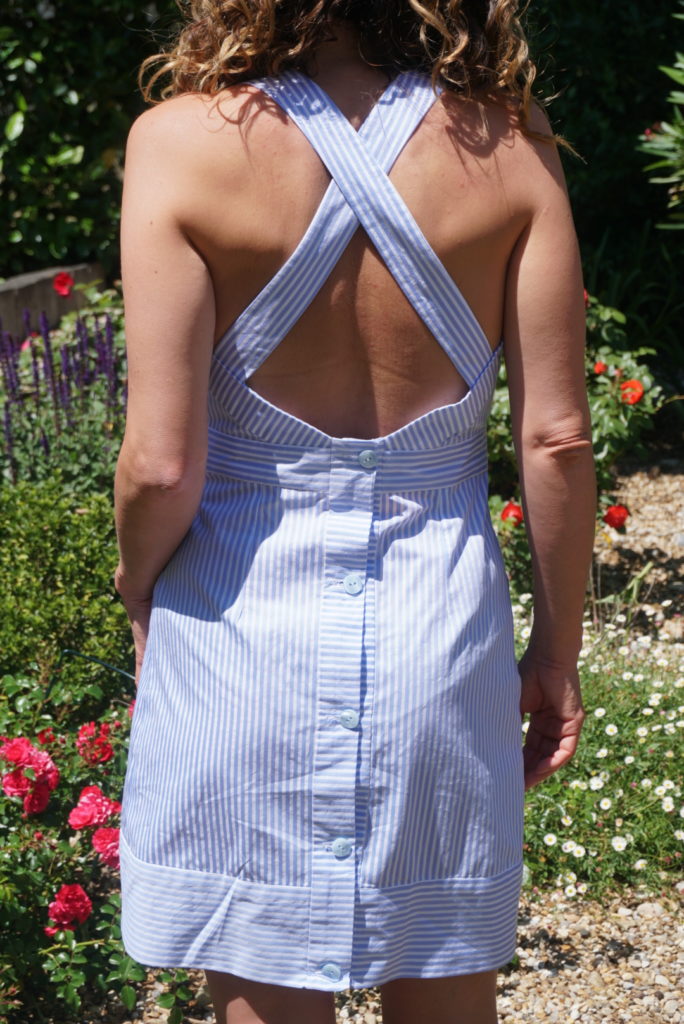
I summary, I really enjoy this pattern: the fit and overall pattern conception are perfect, the style is lovely, and I adore the back straps, back button and skirt pockets. This is not a pattern for beginners, as it has quite a few pattern pieces and conception steps, but it is hugely rewarding for an intermediate seamstress!

The only change I had to make was an FBA and I thought I hadn’t quite got it right because of a slightly pointy boob result. However I did not know how to adjust the FBA further so I kept it for the next version.

For my striped version, it took a lot of thinking to cut the fabric so the stripes would look right. For my broderie anglaise dress, the thinking was all about how to deal with the completely see-through nature of the fabric.
I opted for adding a second layer of fabric – specifically white cotton lawn- on all the pieces requiring it: bodice front, bodice sides, pockets and skirt pieces. I glued both fabric together with temporary fabric glue (WS of broderie to RS of lawn) and then put my dress together following the instructions.
I know this is not the orthodox method to add an under-layer but it worked wonder for me; and I am so pleased with this method that I will definitely use it again for my future broderie anglaise projects. Here is the inside of the dress in any case.
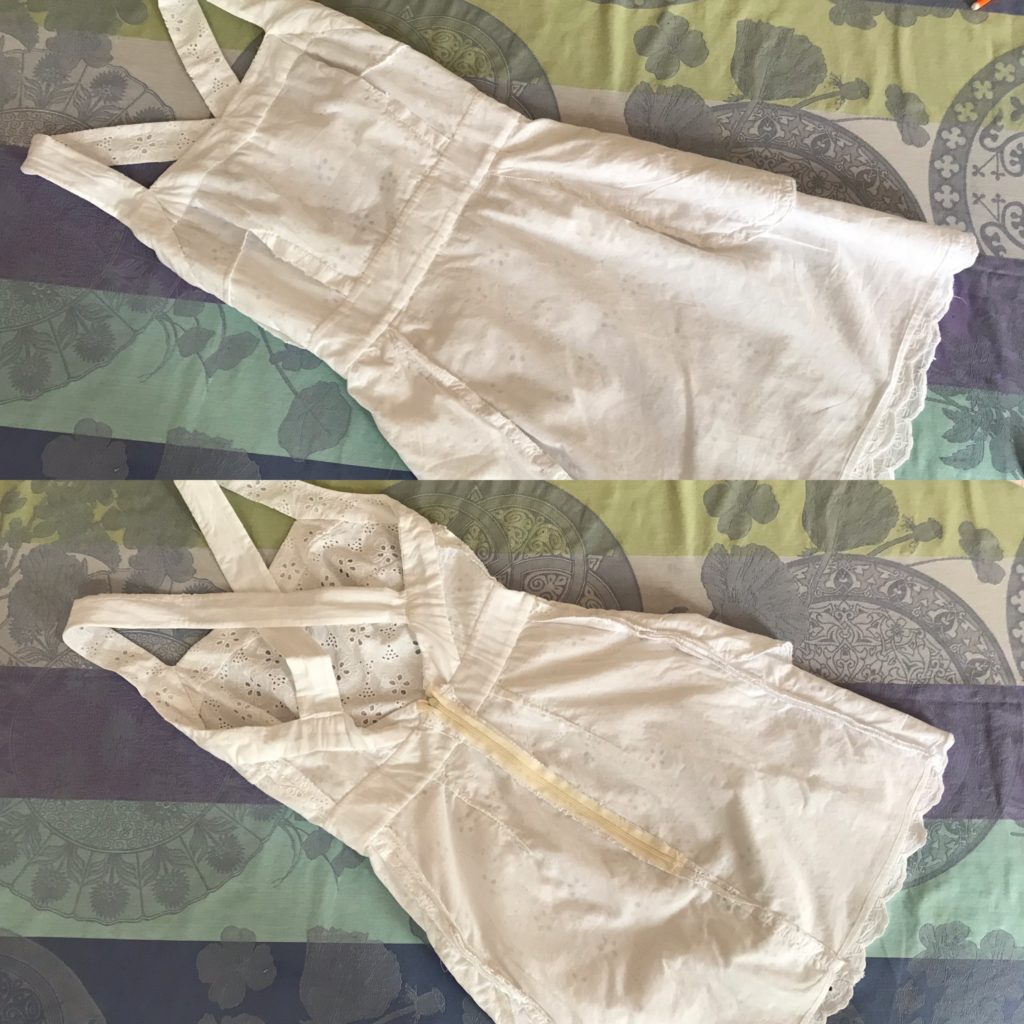
This time I replaced the back buttons of the skirt by an invisible zip (I simply did not add the button plackets) and it did wonder to the bust fit for an obscure reason, no pointy boobs, hurrah!!!


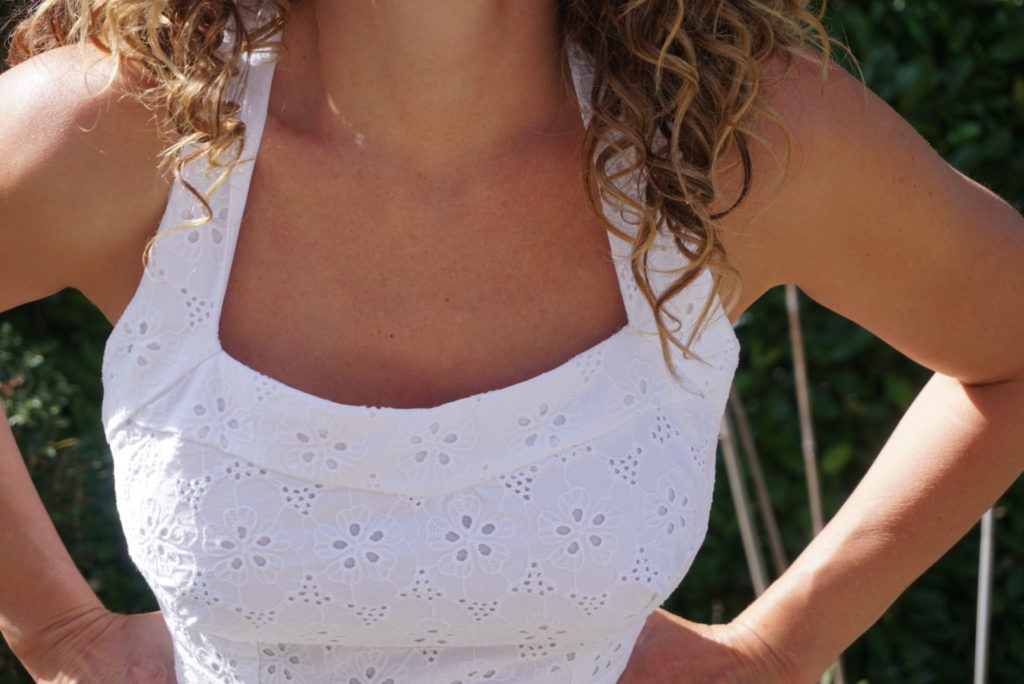
Fabric review
The fabric I used it a stunning white broderie anglaise which I ordered online from French fabric shop Un Chat sur un Fil. I have ordered broderie anglaise before (from China in particular when I couldn’t find what I wanted in Europe) and this is the first time I am so enthusiastic: the fabric is nice and thick, the broderie well defined and very pretty.
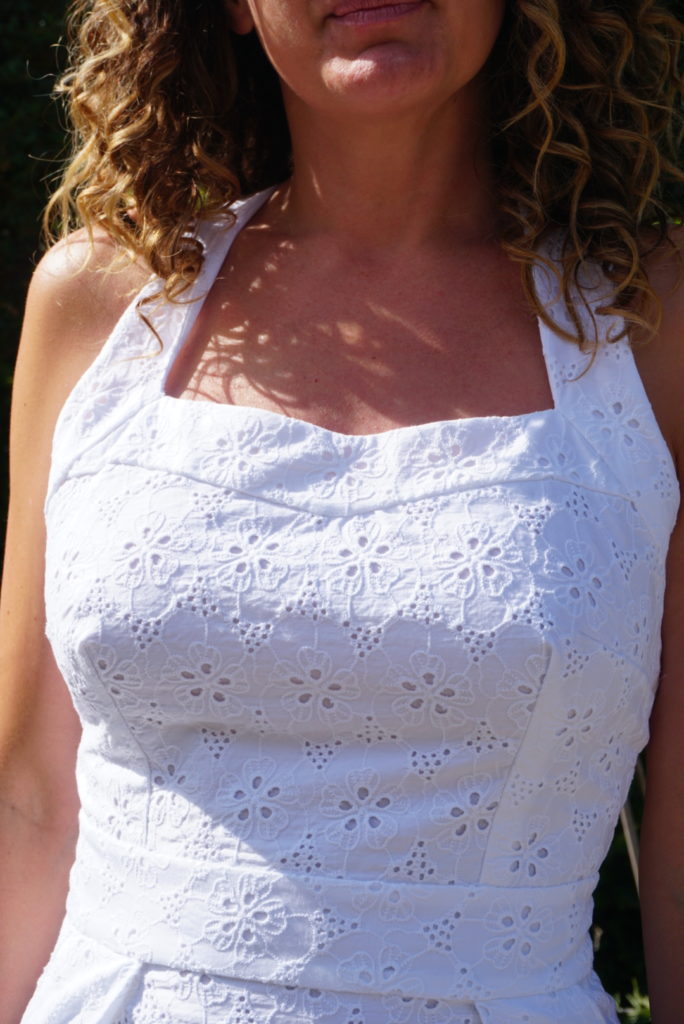
This was my first order from this shop and I was definitely in awe at the quality of fabrics. I also bought some beautiful embroidered cotton with which I made these two other dresses (blog articles here and here), so pleasing to get exactly the fabric quality I was after!

In conclusion
This dress was such a positive experience: better fit than the previous one and the bonus of now knowing how to manage broderie anglaise!
Sadly this is probably my last M7952 dress for this year, as the summer is drawing to an end and I will soon start sewing my autumn wardrobe. But I’m sure I’ll be back to this pattern next year!
Cassandre dress pattern hacks
After sewing my first version of the Cassandre dress (review in this article), I had many ideas of how to hack the pattern – specifically the back and the shoulder straps. So after sewing my green Cassandre dress, I immediately made another …two! So typical!
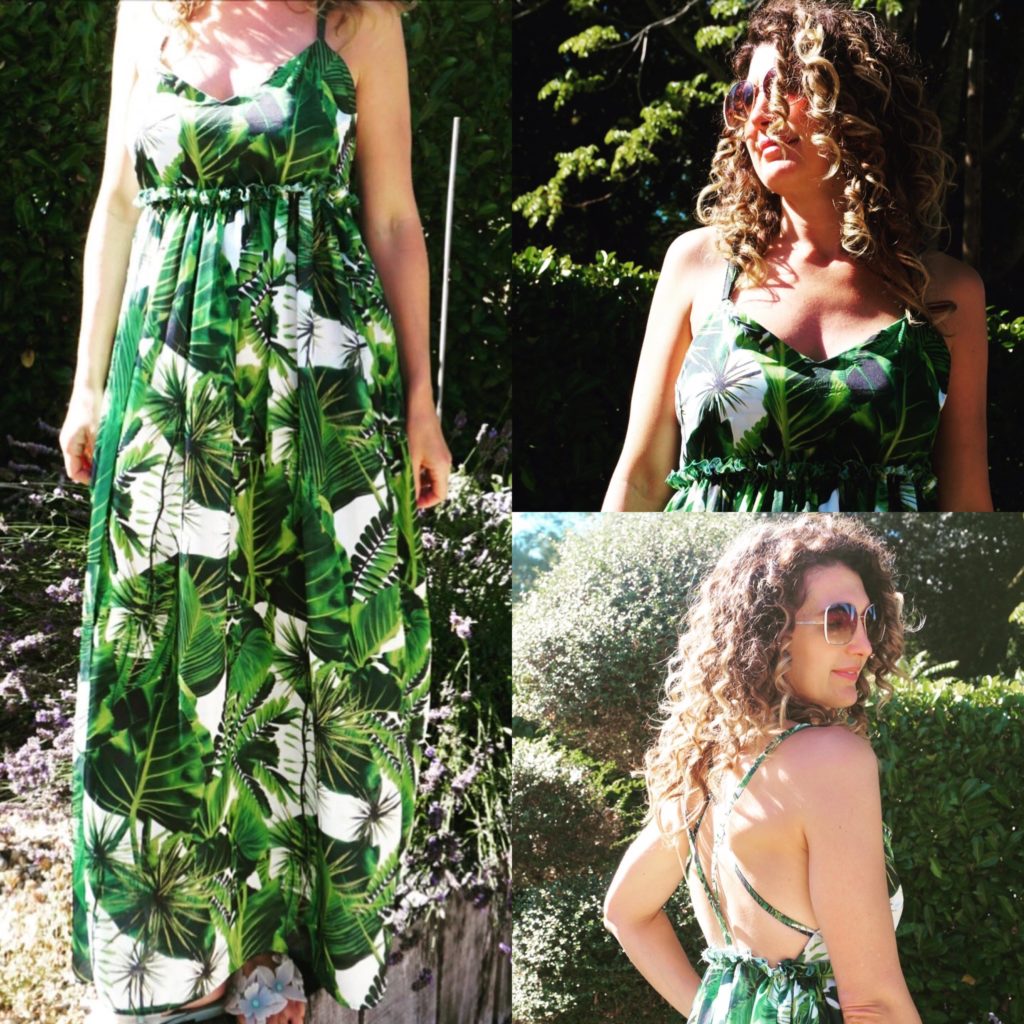
First Cassandre dress hack: with a knotted back
So here is my first hack: a knee-length version with a knotted back, in a beautiful embroidered cotton from Un chat sur un fil.
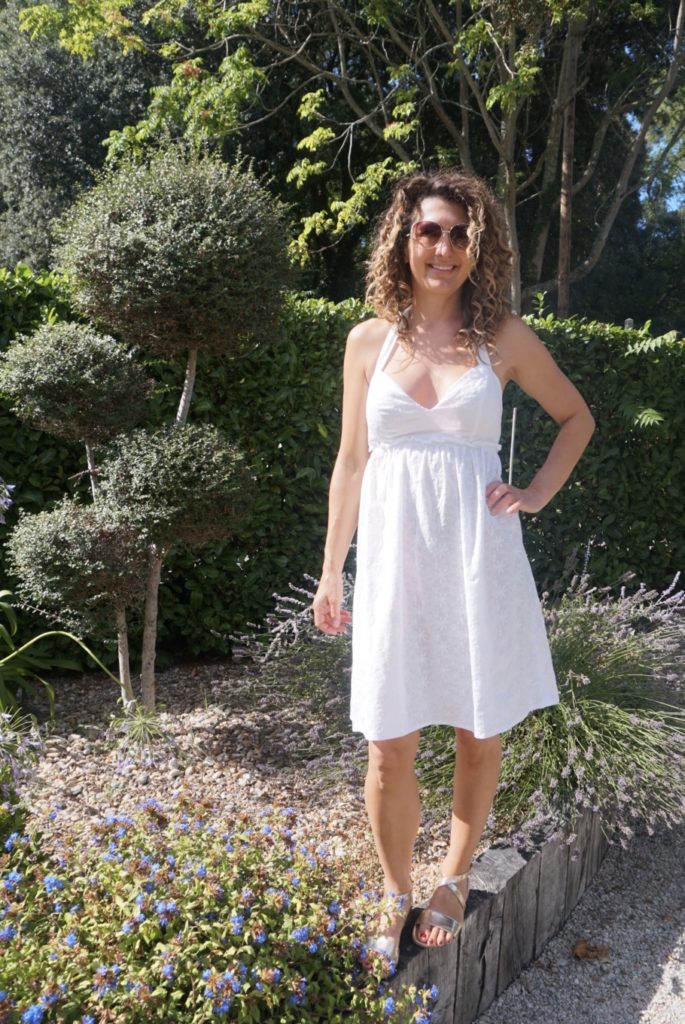

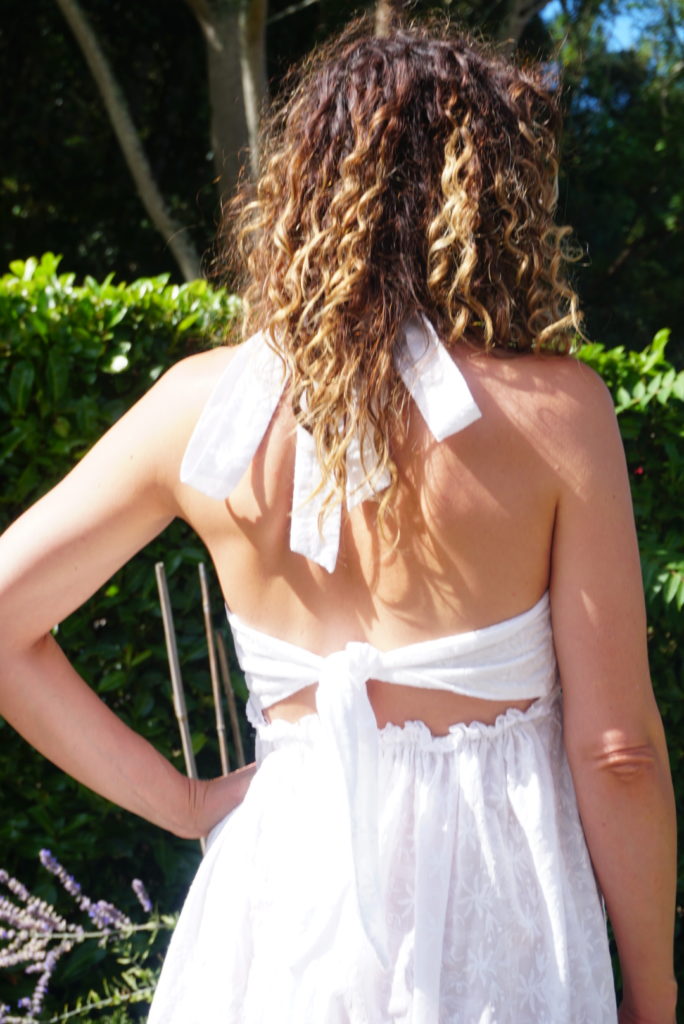
My inspiration was this dress from patterneasy.com, where I particularly liked the high waist, the heart-shapes neckline and… the knotted back of course!
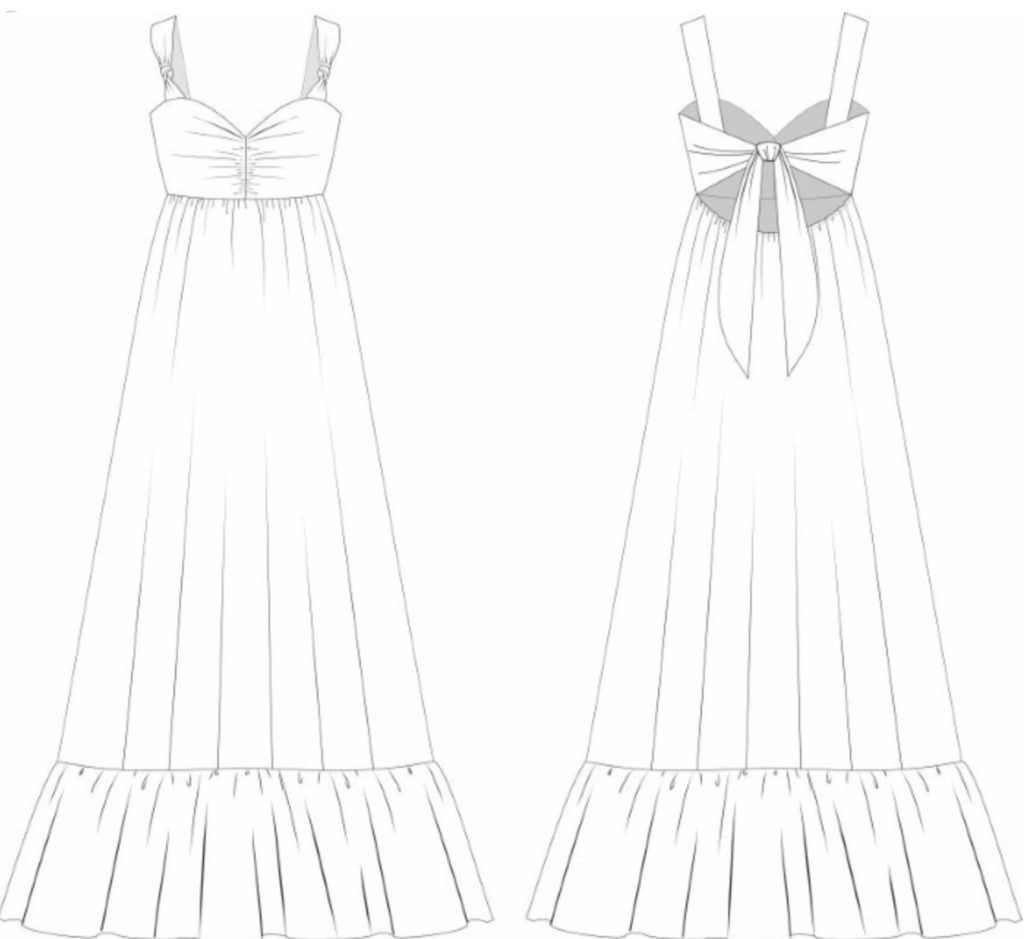
After defying the Russian website and managing to buy the PDF pattern, I got very discouraged by the 60 pages to print and the guaranteed need for a full bust adjustment. I started thinking hard about other options and then realised that by combining the Cassandre skirt and a tweaked version of the McCall’s M7958 top (already used here), I could manage something quite similar.
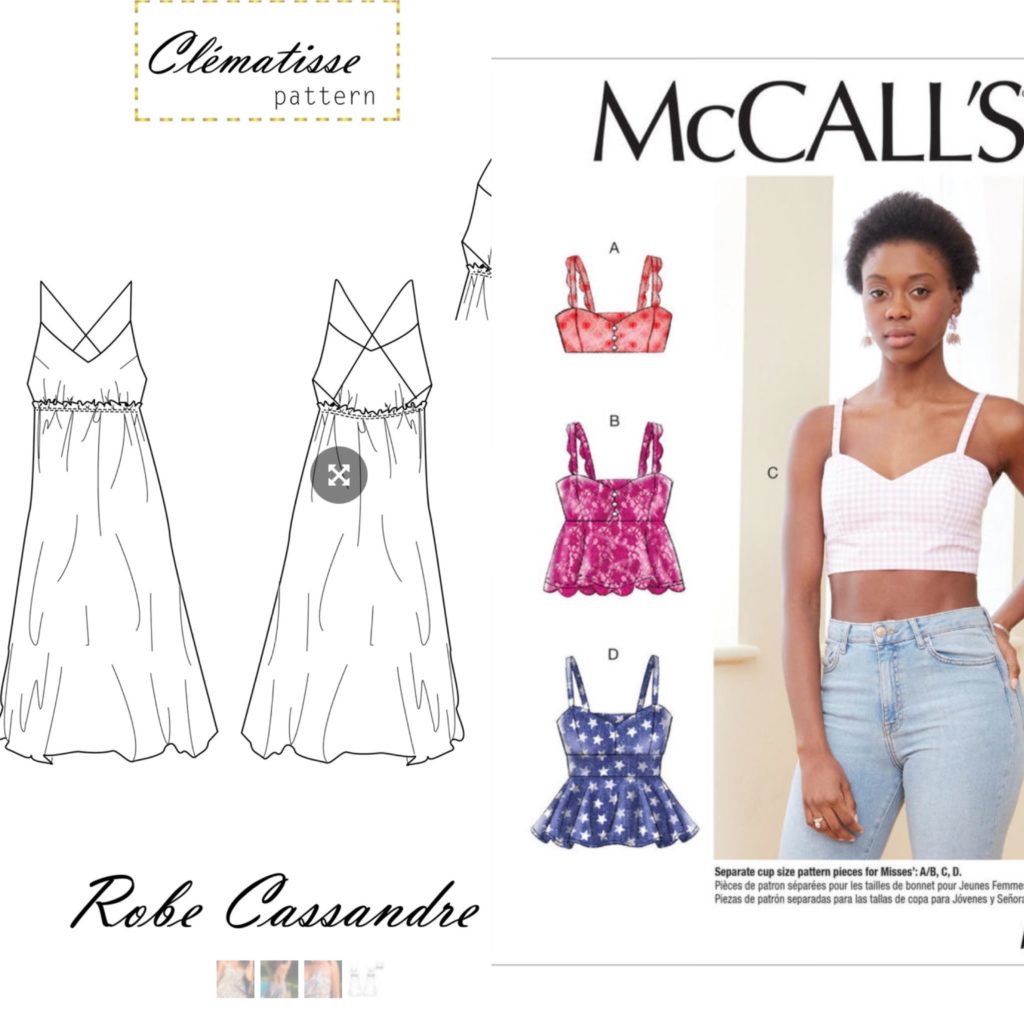
I used view A of the M7958 top as a base. To draft the knotted back on my existing pattern piece, I used the back piece of the Glory top, also from Clematisse pattern, which I made for my daughter earlier this summer but never blogged. This is a very pretty top and a super-easy super-quick make.
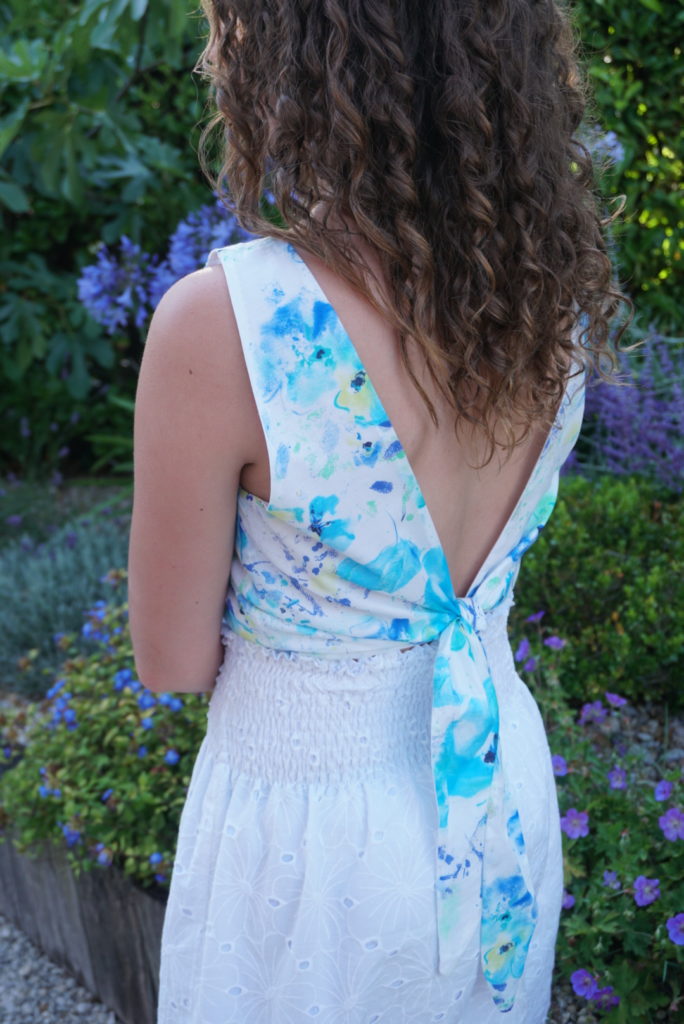
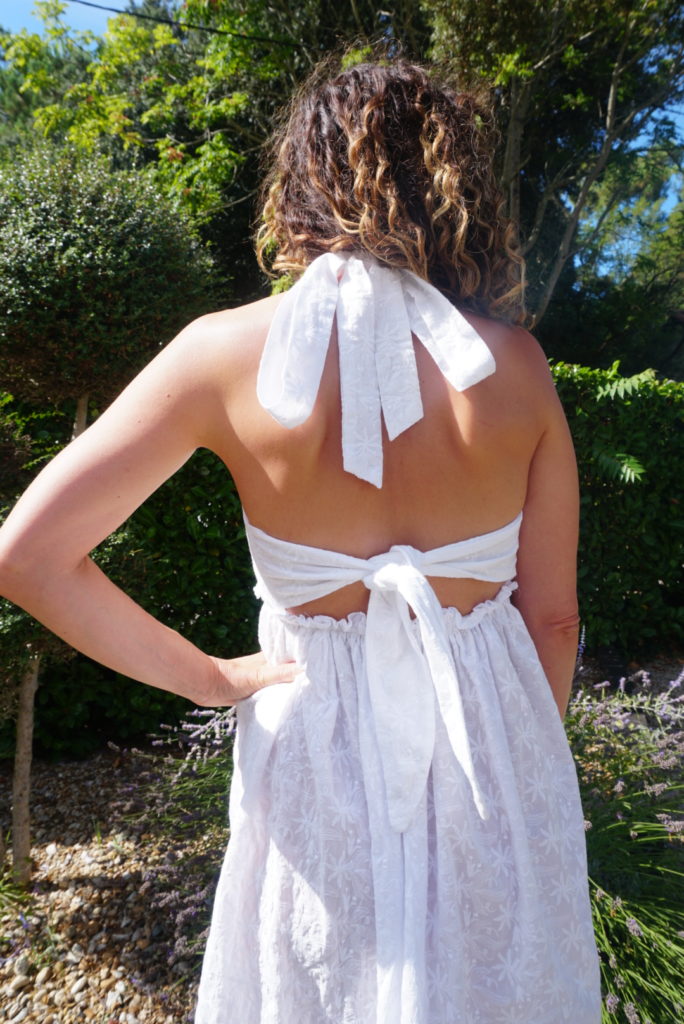
Here is what my back pattern piece looks like versus the original one:
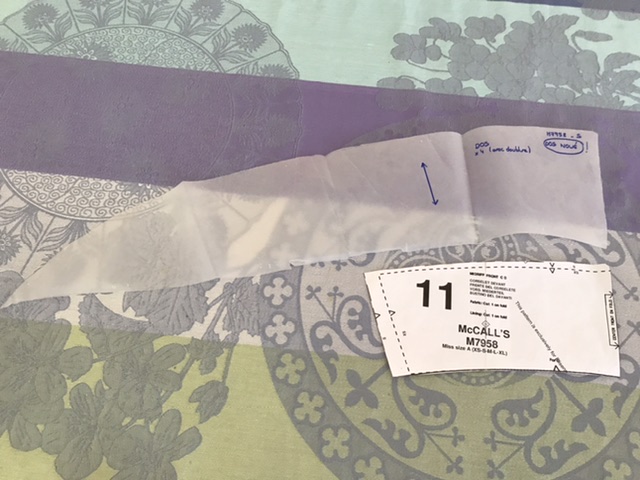
I also lowered the front piece neckline to achieve something looking more or less heart-shaped – I love round curves and I was not a fan of the straight lines of the original Cassandre bodice.
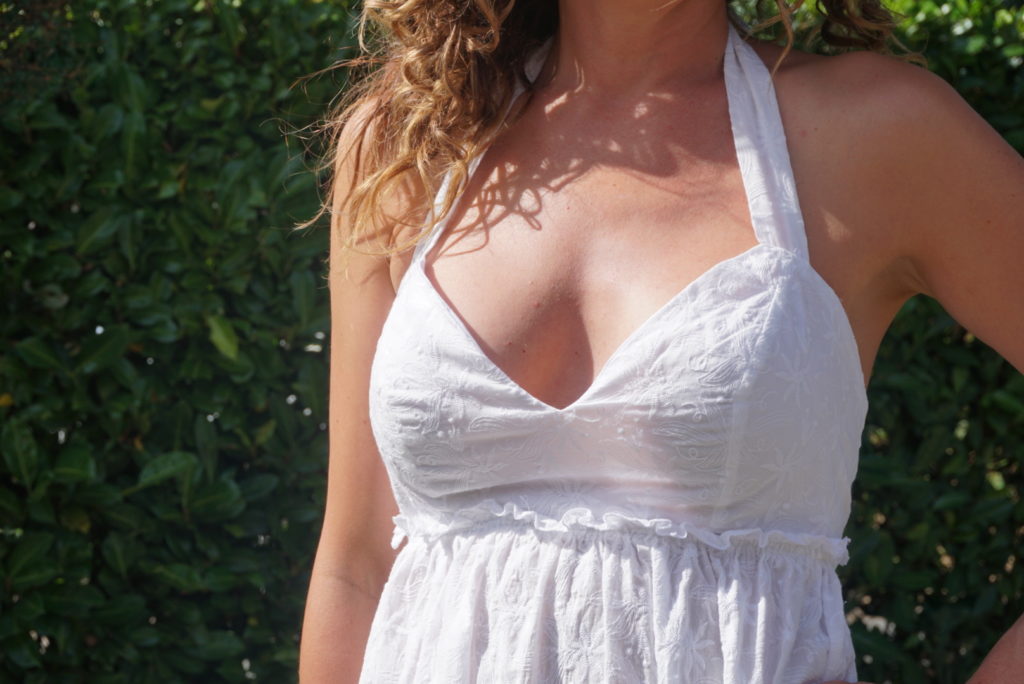

I struggled to figure out how to attach my shoulder straps to the back, so instead I made them knotted at the neck. I am very pleased with this choice, as the two knots complement each other.

Second Cassandre dress hack: Sezane-like with large shoulder straps
And then came the new Sezane collection, among which a number of pieces looking surprisingly similar to popular indie sewing patterns. Quite funny, as usually it is the French sewing community trying to replicate the Sezane collections. Anyway, meet Graziella by Sezane dress, very Cassandre-like in my view!
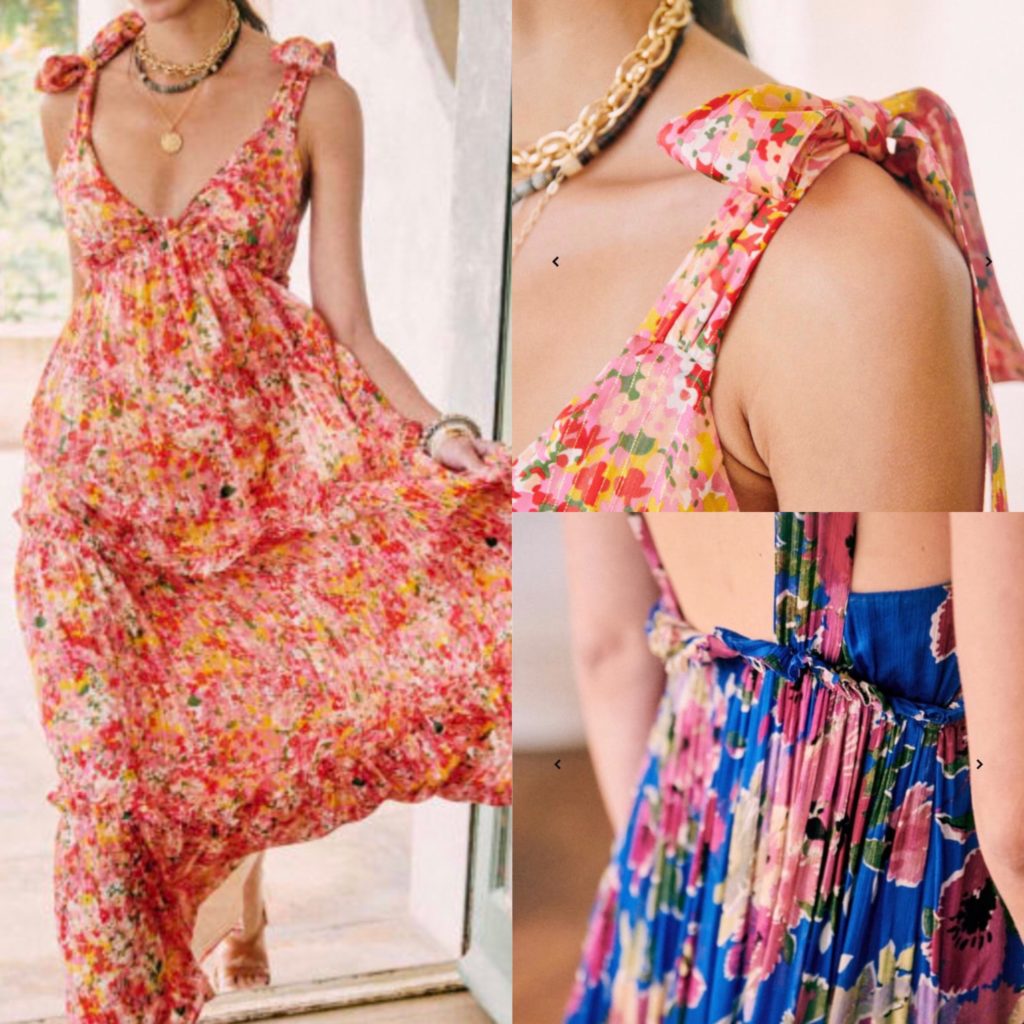
Here the two big changes versus Cassandre as the low cleavage and the very wide shoulder straps – nothing massively difficult to replicate! I reused my M7958 pattern, keeping the heart-shaped neckline at the front and transforming the back piece into a triangle; and I widened the straps to 4.5cm – et voilà!

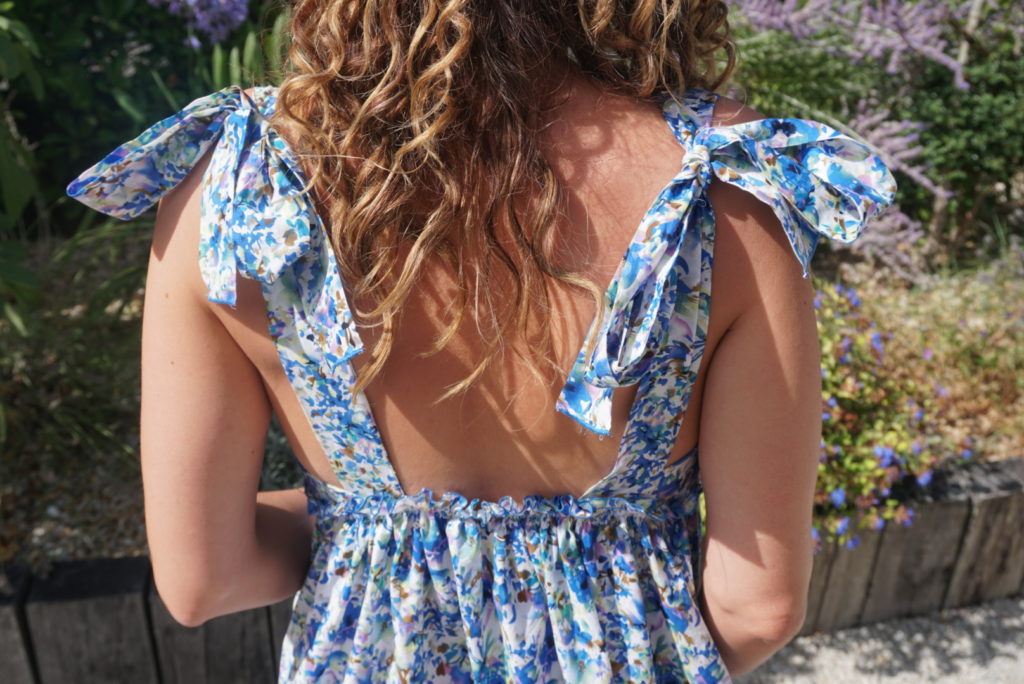
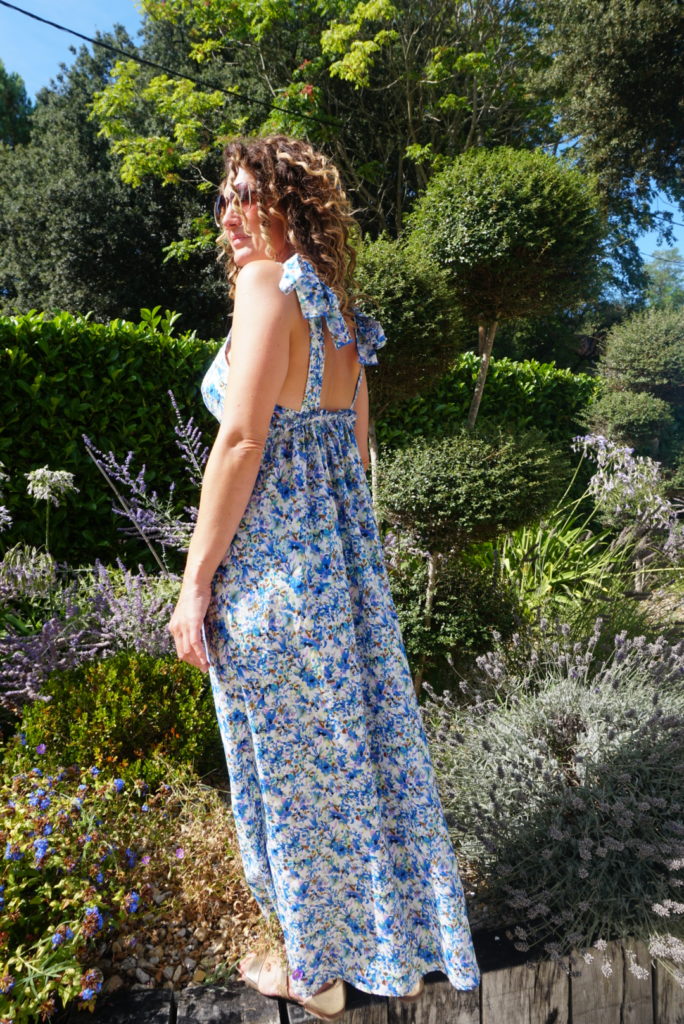
I pondered for ages about replicating the tiered skirt of the Sezane dress but then just went for a simple skirt – I am still thinking I could do it if I order a bit more fabric. Decisisons decisions…
Talking about fabric, this one of a cotton lawn from Croftmill, very lightweight and completely in my summer blue colour scheme with its delicate impressionist floral motif. I am very tempted to order more, tiered skirt or no tiered skirt…
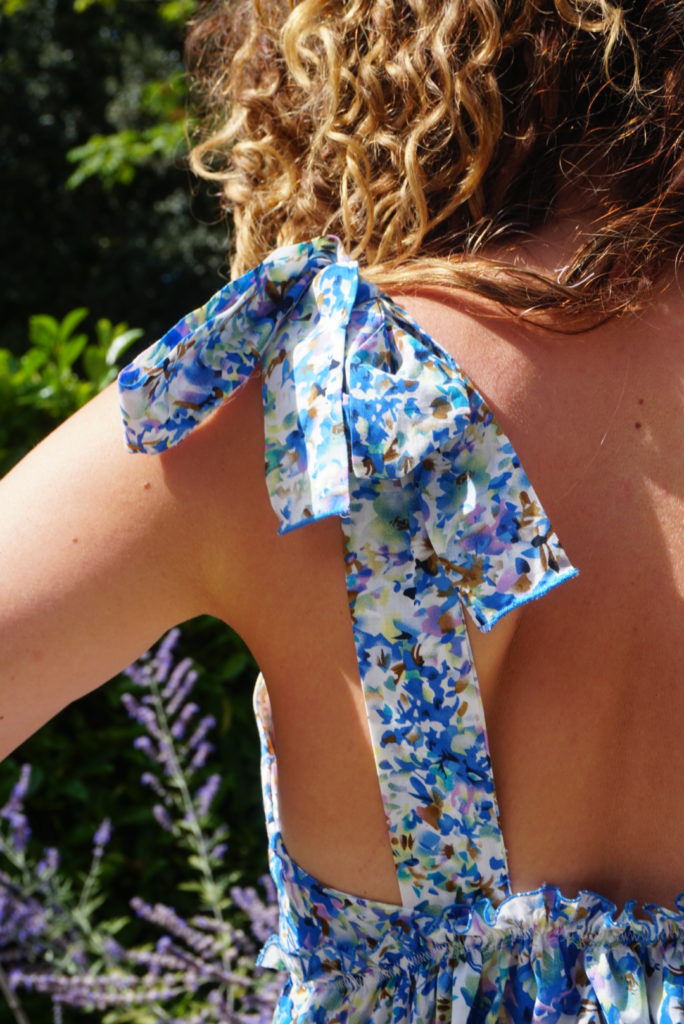
I am not sure I am completely done with Cassandre yet, as I would still like another version in a similar quality to my green one – although I really like my latest two cotton versions, polyester sateen is definitely gorgeous for this pattern and I have just bought three meters… Oh well…
Cassandre, the ultimate summer dress
No matter how successful a pattern is with the sewing community, I usually take ages to sew it – for instance I was two years late to the game for the beautiful and massively popular V9253 dress! (my two versions are here and here). But the Cassandre dress pattern was just too pretty to resist, and far too appropriate for my beachside summer, so here is my first version (of many too come, beware!).
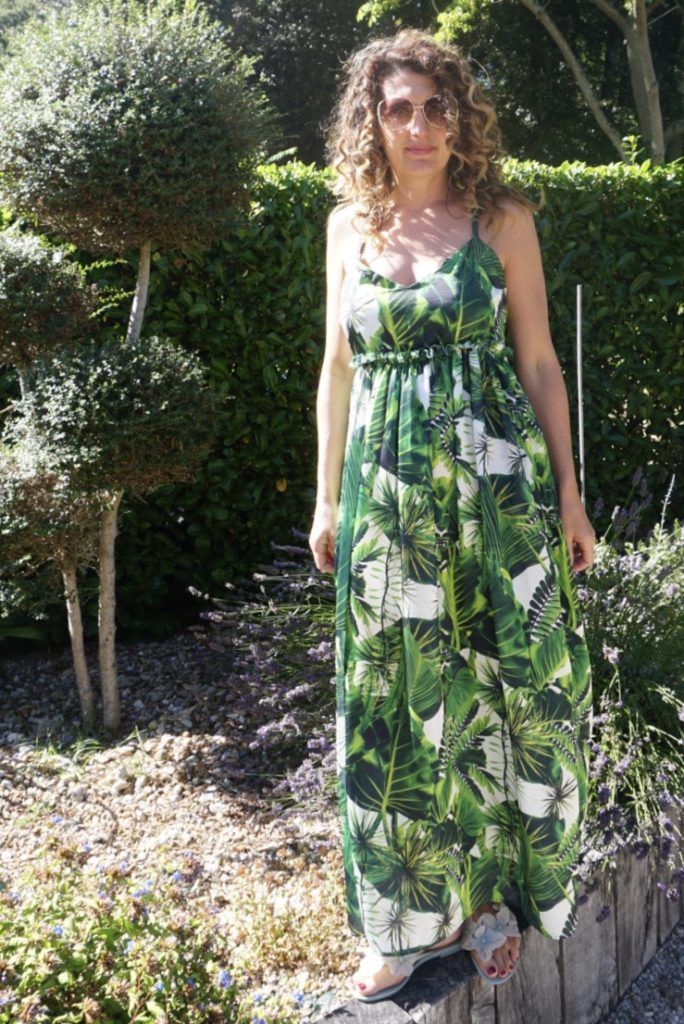

Cassandre dress pattern review
Cassandre is the ultimate summer dress: with it diminutive front bodice, its naked back and its floaty, floor-length skirt, it is the most comfortable thing to wear on hot summer days. I find the style of this dress absolutely gorgeous- although very different from the much more fitted dresses I usually sew and wear.



The skirt is attached to the bodice in the most clever way, via a narrow flat elastic, which allows to pull the dress on and off without any zipper. The skirt ruffles are not sewn within the seams but are visible on the outside, which gives the dress its very distinctive look.
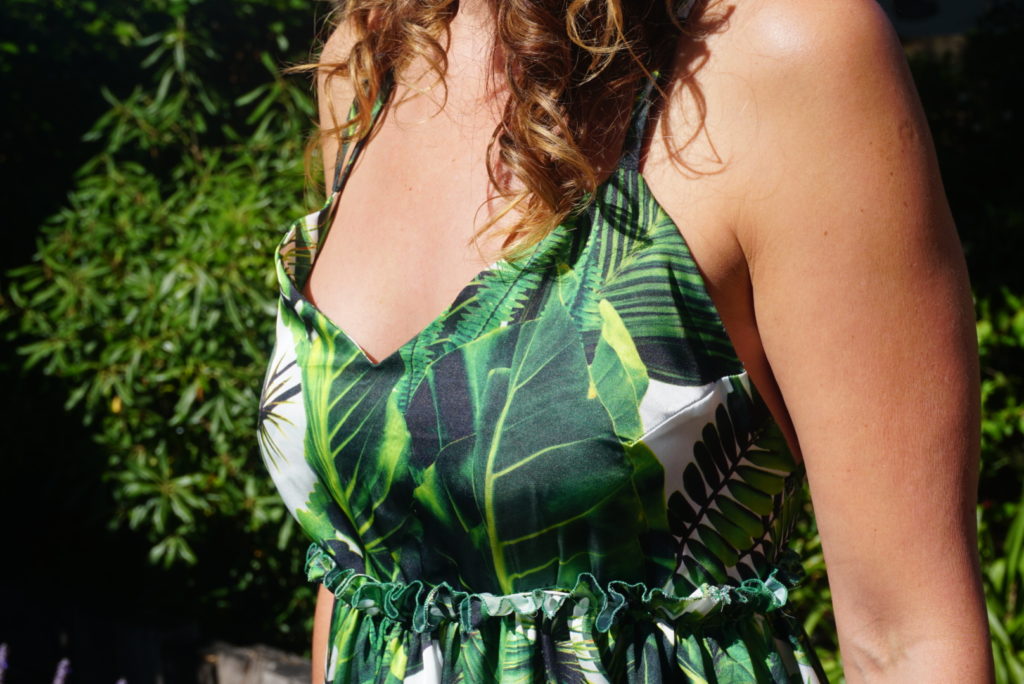
My only reservation about this dress is the front bodice fit, which I find far from perfect – but to be honest I should really have made a full bust adjustment and a muslin and I didn’t bother, so this is largely my fault. For my next versions I will probably used a tried and tested bodice instead of the pattern one.
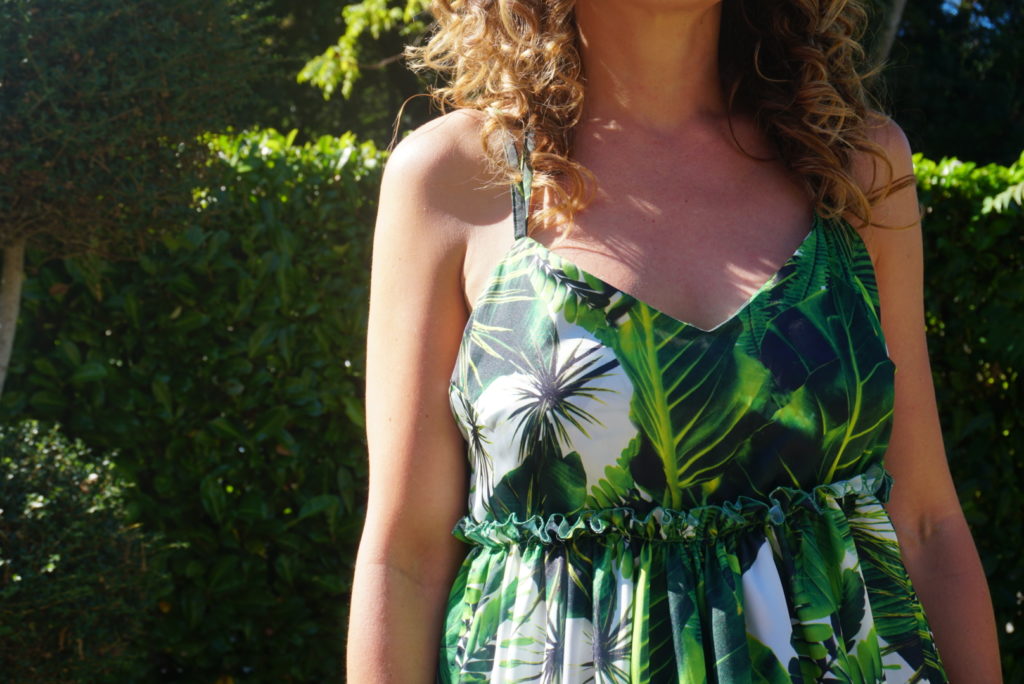
Fabric used
As soon as I discovered the Cassandre pattern, I visualised it in this very fabric I had in my stash – a silky polyester satin with large palm prints from Croftmill. The colour-scheme is not my usual but the palms are so appropriate for a beach dress. The fabric was quite slippery to cut and work with, which did not help my bodice fit, but it is so comfortable to wear in the heat that I am (nearly) ready to forget this.
That said my next versions will be in something a bit less difficult to work with – I have some embroidered cotton and some cotton lawn lined up.
Hacks and adjustments to the pattern
The pattern indications are extremely detailed and straightforward. The one thing I however modified was the length of elastic used for the waist, which I reduced substantially. I had seen many version of Cassandre with a dropping back and I really wanted to avoid this look, so I measured my own waist for the front elastic; and I cut the back elastic in situ.
I also played quite a bit with the back straps. The pattern originally comes with two straps, which can be crossed on the back or bowed at the neck. I made four and positioned then in double-cross, a very fun idea but which took me absolutely ages to adjust (and with a lot of help from “Carl” (Lagarfeld), the name I give my husband when he gets involved in my sewing projects).
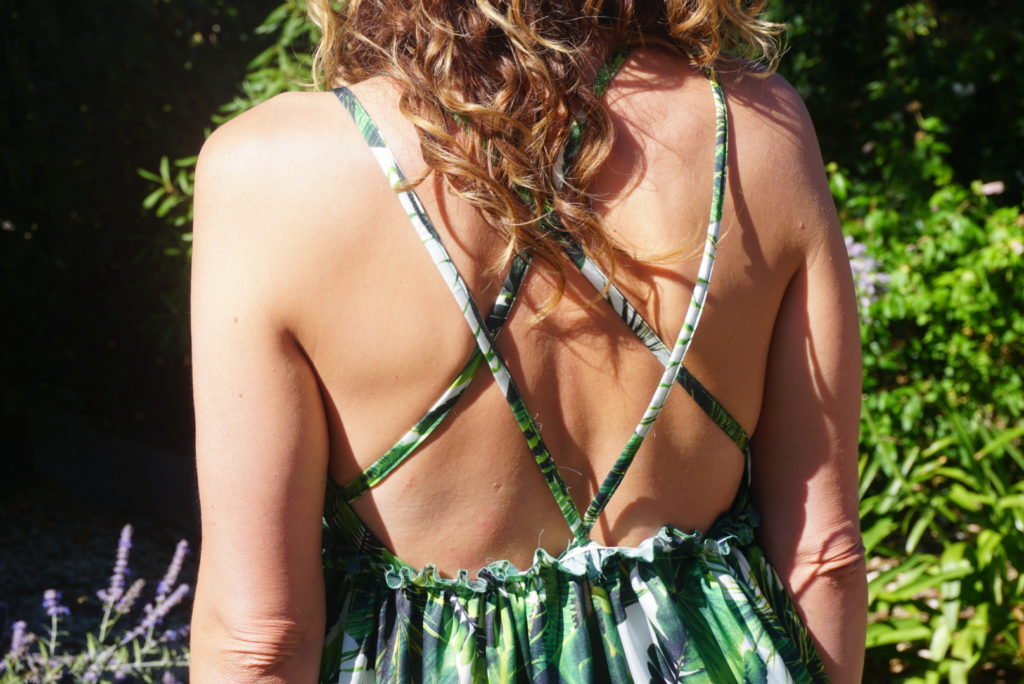
But I have many ideas on how this dress could be hacked further so do expect to see more versions on the blog soon…
My first silk shirred dress
You know my love for shirred dresses and my quasi industrial production over the past two years – I hardly wear anything else in July and August so this is totally justified in my view! Most of my shirred dresses are in lightweight cotton (voile, Swiss dots, baptiste), a few in satin polyester (surprisingly fresh for a non-natural fibre) but I had never dared shirring silk until… now! Tada, here is my first silk shirred dress (and without doubt not the last!):
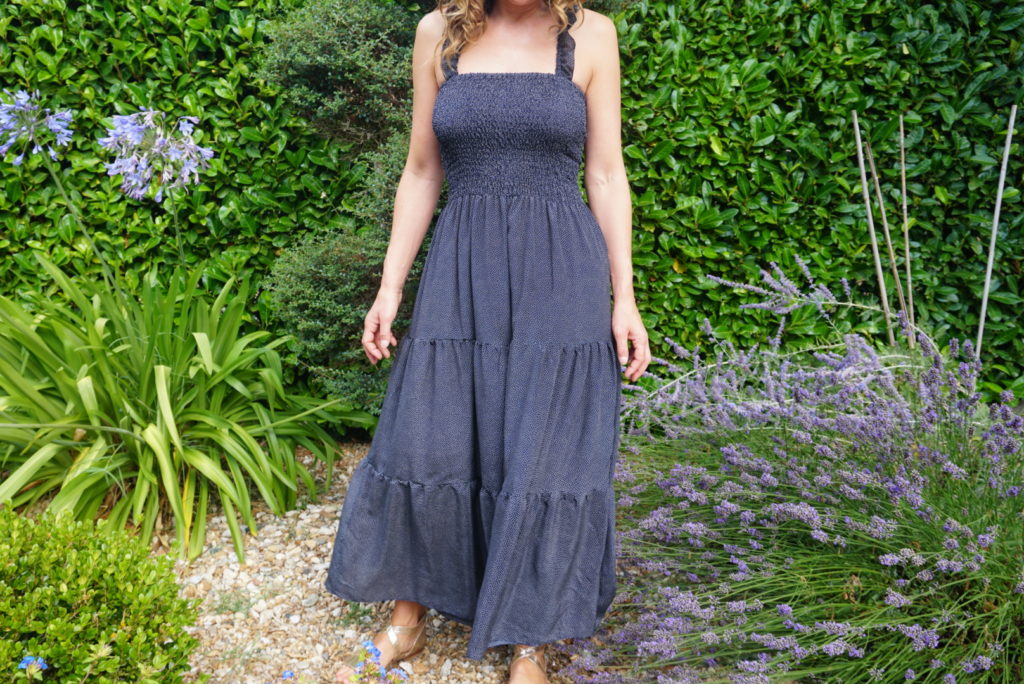
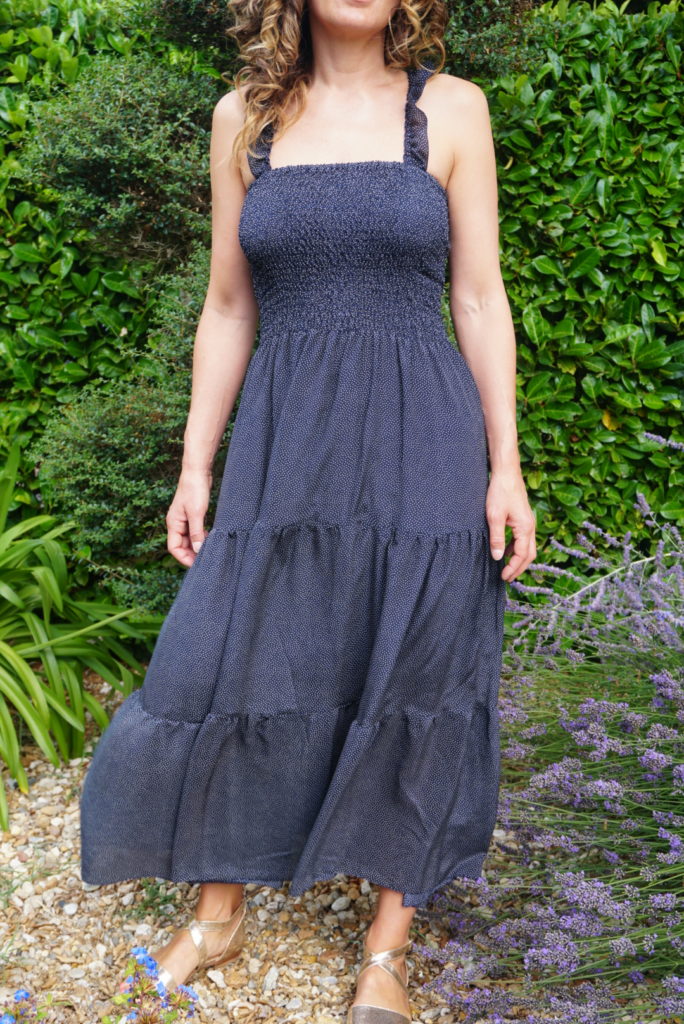
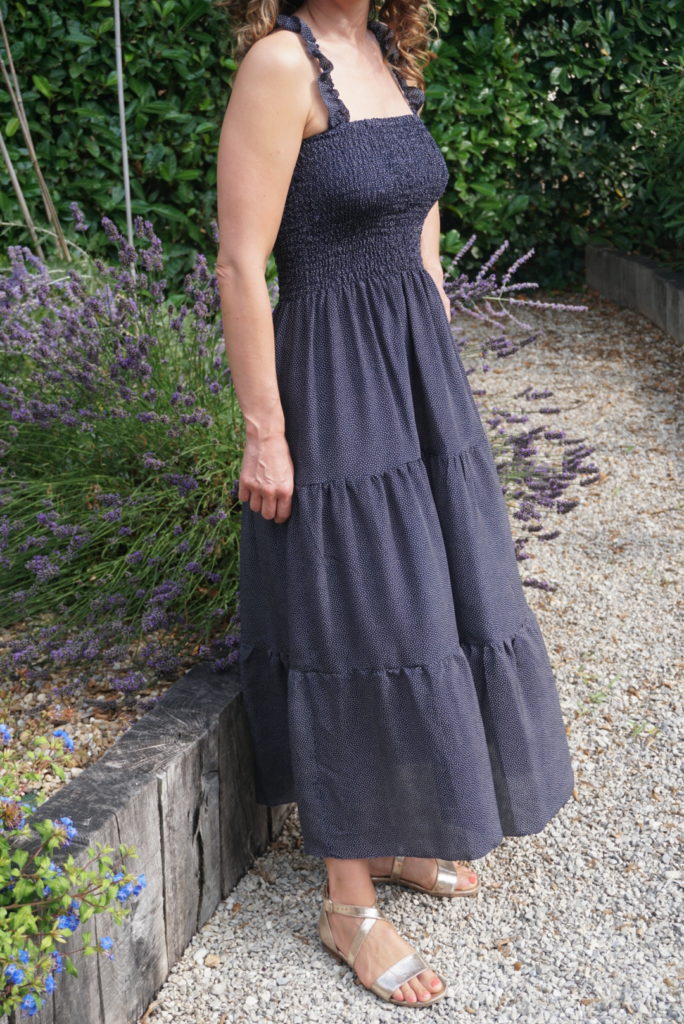
I had never tried to shirr silk before because I dreaded tearing the fabric while shirring – the bobin needs to be threaded with elastic, as I explained in this tutorial, and I thought this might be too thick to be compatible with silk. However, it turned out that the only thing I needed to change was my needle: I used a Microtex needle and the sewing process what incredibly easy. The shirred part of the dress is very similar to that of all my other shirred dress and I genuinely had no issue whatsoever.
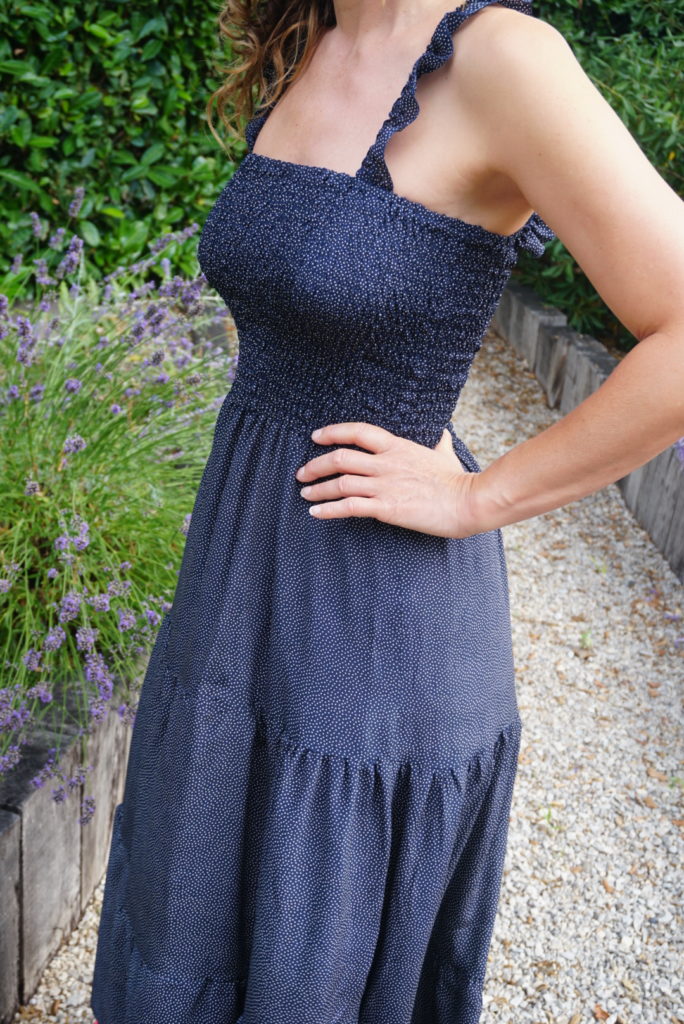

The silk fabric is from Bennytex, my go-to online shop for amazing bargains. They recently had a big arrival of silk and I ordered like a madwoman, as I am a real fabric snob and I will always prefer natural materials (wool, cotton, silk) over man-made – especially when they are so affordable.
This one is described as a silk crepe (although the structure is very regular), it is opaque navy with irregular white dots and it is fine but actually a pleasure to work with.
This new silk dress is a twin to this maxi shirred and tiered one, for which I wrote a very detailed tutorial.
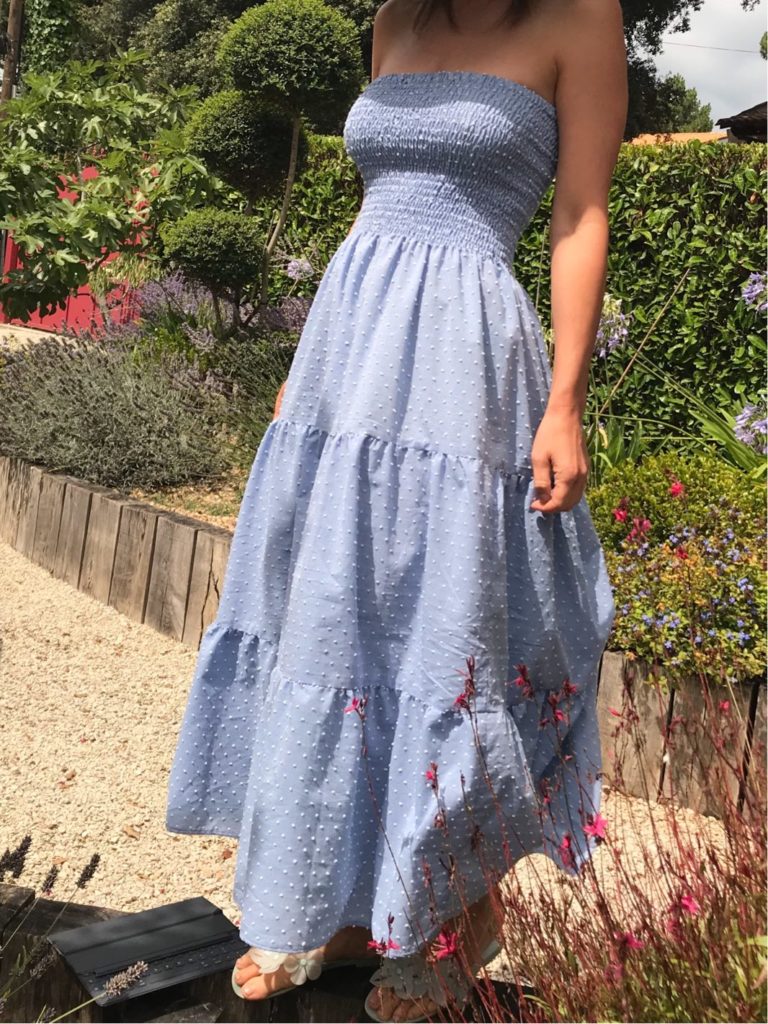
For once I added shoulder straps. I cut two 150x5cm rectangles, finished the sides with very narrow zigzag stitches and sew two lines of shirring; then adjusted the length in situ. I crossed the straps in the back and I am quite pleased with the result.
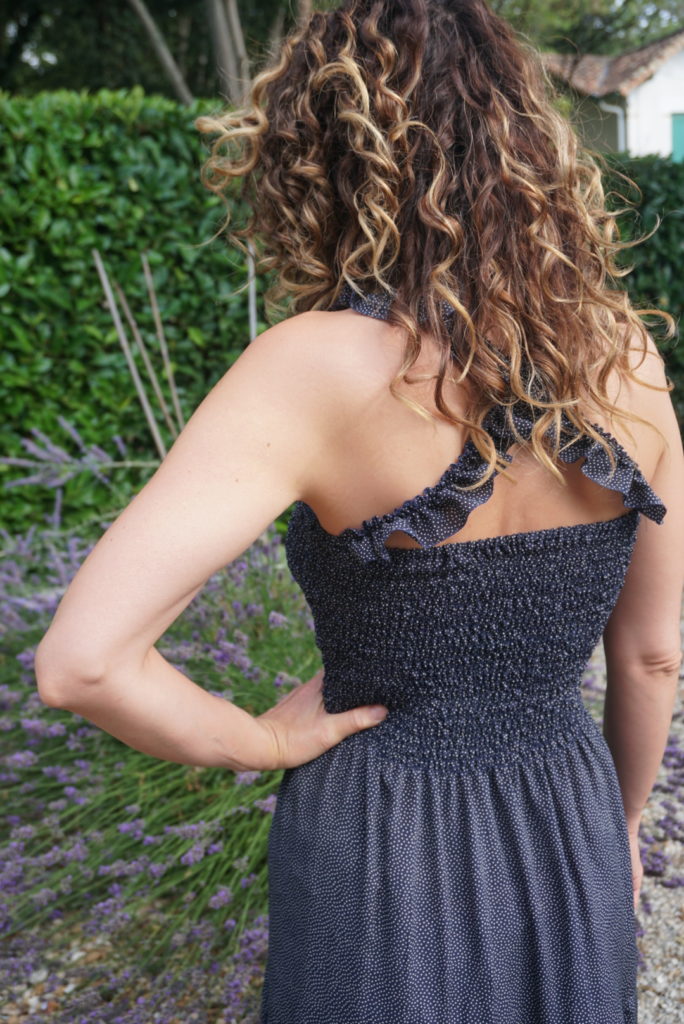
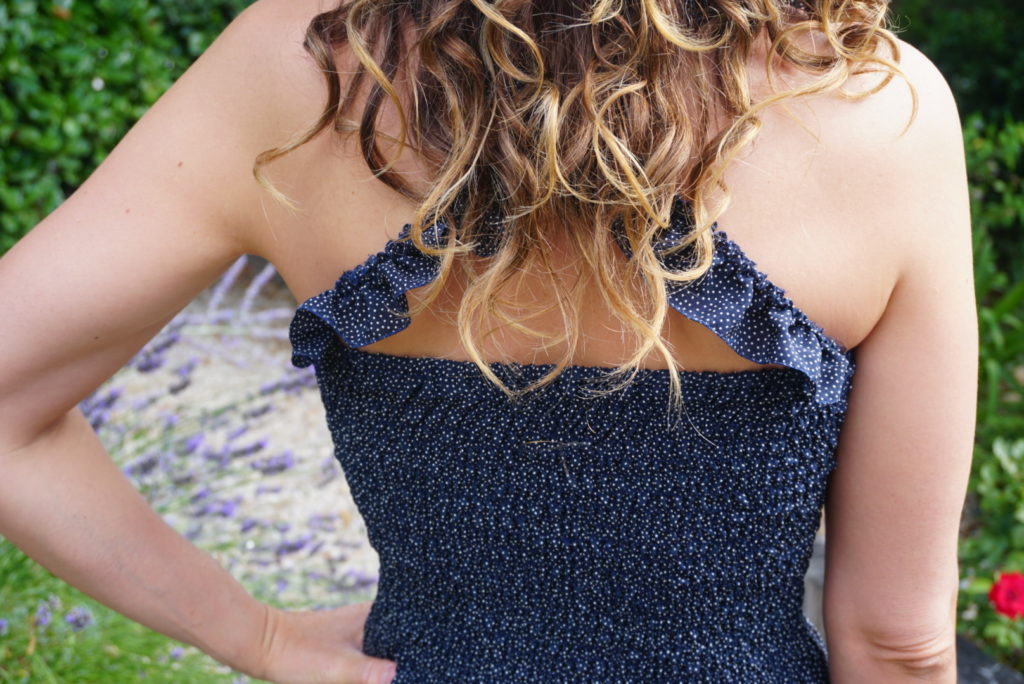

Not much to add about this beauty, which will get extensive use like all my other shirred babies.
YOU MAY ALSO BE INTERESTED IN THESE THREE FREE TUTORIALS:
